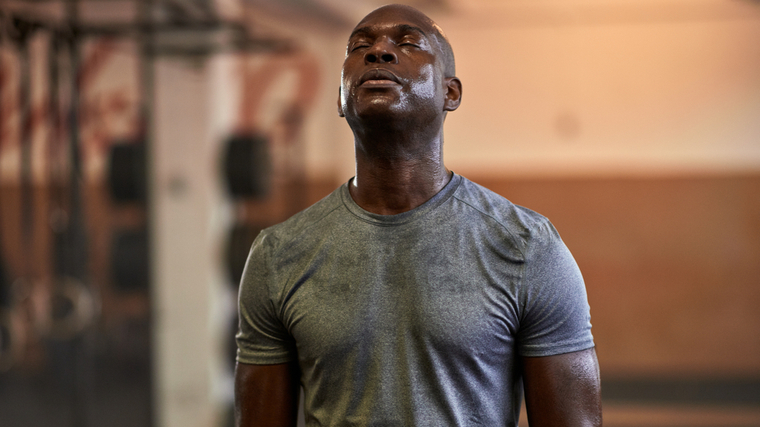Fewer phrases in the fitness industry live in infamy like “stoke your metabolic fire.” From green tea, to fasted cardio, to eating every three hours (or was it two?), setting your metabolism ablaze is all the rage.
Strength coach and content creator Jeff Nippard took to YouTube on June 11, 2023, to unpack the science behind human metabolism and, more importantly, explain what actually works. If you’ve tried to lose weight or burn fat in the past with mixed results, employing one or more of these strategies just might be what you need to move the needle.
[Related: What’s the Average Biceps Size, and How Do You Stack Up?]
Below, you’ll find an abbreviated version of the main arguments Nippard makes in his video, as well as some specific, actionable steps you can take. For more in-depth recommendations or explanations of his rationale, your best bet is to watch the video in full.
Editor’s Note: The content on BarBend is meant to be informative in nature, but it should not be taken as medical advice. When starting a new training regimen and/or diet, it is always a good idea to consult with a trusted medical professional. We are not a medical resource. The opinions and articles on this site are not intended for use as diagnosis, prevention, and/or treatment of health problems. They are not substitutes for consulting a qualified medical professional.
What Is Metabolism?
To make headway with your metabolism, Nippard argues that you need to begin by understanding its definition in the first place. Scientifically speaking, metabolism refers to all of your body’s active regulatory processes — chemical reactions like digesting food, utilizing oxygen, or burning calories.
In the fitness industry, a person’s metabolism colloquially refers to their basal metabolic rate (BMR) — how many calories they burn just by existing in the first place, coupled with the calories burned through any type of physical activity.

Nippard cites data (1) showing that your own metabolism can differ wildly from others, even those of similar stature to you: One 80-kilogram (176.3-pound) individual can burn over 4,000 more calories per day than another person of the same weight.
However, that massive gulf comes from a combination of genetic differences like sex or BMR and actionable factors like physical activity or dietary choices. And the latter, Nippard argues, are where you should direct your efforts.
How to Boost Your Metabolism
Nippard lets the studies do the talking and wisely breaks down the available research into three categories: What (probably) works, what might work, and which practices aren’t well-supported.
Here are the options that he believes have legitimate evidence-based support, and how you can implement them into your own lifestyle.
1. Gain Muscle
A pound of lean skeletal muscle burns roughly three times more calories per day, just by existing, than a pound of fat. Nippard argues that one of the most reliable ways to kick up your daily metabolism is to build some muscle.
According to Nippard’s math, he suggests that adding 30 pounds of muscle mass would increase your metabolic rate by almost 200 calories per day. Now, an extra 30 pounds is a staggering amount for some folks, particularly women. However, bear in mind that muscle does a whole lot more than just burn calories.
How to Do It
More muscle mass will improve your body composition, increase your strength, and stabilize your joints. So, if you want to bulk up a little, here’s how to start:
- Start a resistance training program on your own or hire a personal trainer.
- Employ progressive overload to continue challenging your body, encouraging muscle growth.
- Eating a caloric surplus will speed up the rate at which you gain muscle, but may dampen your ability to lose fat in the process.
If you’re new to weight training, however, you don’t need to eat piles of food to add muscle. As long as you stick to a routine and hit the weights a couple of times per week, you should start putting on muscle without having to overfeed yourself. (2)
2. Eat More (Sort Of)
When you restrict your food intake for an extended period of time, your internal machinery (more specifically, your metabolism) slows down somewhat. Less food coming in means less “work” to do. In the literature, this process is called metabolic adaptation.
You can combat this dampening of your metabolic rate and maintain a faster relative metabolism, Nippard argues, by dieting down slowly. Eating more food than you otherwise might and aiming for a moderate rate of weight loss via a caloric deficit should help you keep your metabolism in fighting shape.
How to Do It
Nippard encourages that, if you’re trying to shed pounds, you should lose no more than half a percent to one percent of your body weight per week. This recommendation aligns with modern research-based recommendations. (3) Here’s how to precisely calibrate your rate of weight loss:
Calorie Calculator
- Use a calorie calculator (like the one above) to determine how many calories you burn on a daily basis.
- Subtract a specific amount from that number to create a caloric deficit.
- Your caloric deficit depends on how much weight you can lose in a week.
From here, you’ll need to do some math.
- If you weigh 150 pounds, one percent of body weight amounts to a one-and-a-half-pound weekly ceiling.
- One and a half pounds of fat consists of 5,250 calories (a pound contains 3,500).
- To lose one percent of your body weight over a week, you’d divide that number by seven and get a 750-calorie daily deficit as your metabolic “ceiling”.
It may not elevate your BMR in a literal sense, but taking a sustainable approach to your energy balance can help mitigate the negative effects of metabolic adaptation — what is sometimes labeled as “starvation mode.”
Losing weight too quickly can result in metabolic damage, muscle loss, chronic fatigue, hormonal dysfunction, and a host of other negative consequences, many of which are temporary.
3. Increase Your NEAT
Your metabolism is the sum of internal factors that you can’t control, combined with your overall activity level. That activity is further split into two categories: dedicated exercise and what’s called non-exercise activity thermogenesis (NEAT).
Think of NEAT as the energy your metabolism burns to physically keep your body moving. Everything from doing house chores to typing on a keyboard to darting your eyes across these very words burns calories.
How to Do It
You may not have time to kick up your caloric expenditure by spending more hours in the weight room or on a treadmill. But Nippard suggests you can sneakily boost your metabolism by enhancing your NEAT. This can take the form of making small lifestyle adjustments to your daily habits, such as:
- Parking as far away as possible in the parking lot of the grocery store.
- Taking the stairs rather than the elevator at work.
- Pacing around your home while taking a phone call rather than sitting down.
- Opt for a standing desk if you work from home.
- Do your dishes by hand rather than using your dishwashing machine.

You may think of your workouts as the main activity in your lifestyle that burn calories, but NEAT actually accounts for a majority of all activity-related metabolic enhancement. Make a small effort to move around a bit more outside of the gym and your metabolism should kick up a notch.
Other Options Include…
Nippard acknowledges that other metabolism-boosting practices fall into a gray area of “might work,” while some have limited to no evidence-based support.
For instance, he outlines that these factors may boost your metabolism in a small capacity, but more research is needed to be sure:
- Increasing your water intake
- Eating more spicy foods
- Reverse dieting protocols
- Wearing a weighted vest during the day
These practices may result in small or inconsistent increases in metabolic rate, but Nippard doesn’t regard them as substantial enough to hang your hat on. Conversely, these popular metabolism-boosters don’t actually stand up to scientific scrutiny (according to Nippard):
- Green tea
- Sauna
- Cold plunges
- Eating more frequently
Many of these have been touted in the past as popular tools for boosting BMR, but lack substantial empirical support. You can try them if you like, but don’t expect any real results.
Light Your Fire
Nippard uses science to throw some cold water on a couple of hot trends in the fitness industry. Eating six, or seven, or 14 meals per day won’t “stoke your metabolic furnace,” but hitting the weights hard should provide some tangible benefit to your metabolism.
Ultimately, your best bet is to keep it simple. If you’re trying to boost your metabolism to lose weight, you should practice moderate dietary restriction, exercise regularly, and find clever ways to be a little more active a lot of the time. After that, it’s a game of patience. If you’re a fan of fables, you know the tortoise beats the hare every time.
More Nutrition Content
- The Nitric Oxide Side Effects You Need to Know About
- Creatine vs. Pre-Workout: Differences and When to Take Them
- The Best Types of Supplements for Performance and Weight Loss
References
- Pontzer, H., Yamada, Y., Sagayama, H., Ainslie, P. N., Andersen, L. F., Anderson, L. J., Arab, L., Baddou, I., Bedu-Addo, K., Blaak, E. E., Blanc, S., Bonomi, A. G., Bouten, C. V. C., Bovet, P., Buchowski, M. S., Butte, N. F., Camps, S. G., Close, G. L., Cooper, J. A., Cooper, R., … IAEA DLW Database Consortium (2021). Daily energy expenditure through the human life course. Science (New York, N.Y.), 373(6556), 808–812.
- Slater, G. J., Dieter, B. P., Marsh, D. J., Helms, E. R., Shaw, G., & Iraki, J. (2019). Is an Energy Surplus Required to Maximize Skeletal Muscle Hypertrophy Associated With Resistance Training. Frontiers in nutrition, 6, 131.
- Ruiz-Castellano, C.; Espinar, S.; Contreras, C.; Mata, F.; Aragon, A.A.; Martínez-Sanz, J.M. Achieving an Optimal Fat Loss Phase in Resistance-Trained Athletes: A Narrative Review. Nutrients 2021, 13, 3255.
Featured Image: Jeff Nippard on YouTube